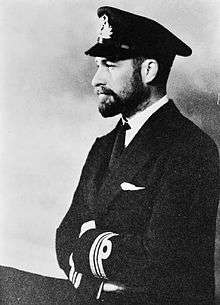Stephen Beattie
Captain Stephen Halden Beattie VC (29 March 1908 – 20 April 1975) was a Welsh recipient of the Victoria Cross, the highest and most prestigious award for gallantry in the face of the enemy that can be awarded to British and Commonwealth forces.
Stephen Halden Beattie | |
|---|---|
 | |
| Born | 29 March 1908 Leighton, Montgomeryshire |
| Died | 20 April 1975 (aged 67) Mullion, Cornwall |
| Buried | Ruan Minor Churchyard |
| Allegiance | |
| Service/ | |
| Years of service | 1927-1960 |
| Rank | Captain |
| Commands held | HMS Campbeltown |
| Battles/wars | World War II |
| Awards |
|
| Other work | Naval Adviser to the Ethiopian Government (1965) |
‘Sam’ Beattie was born at Leighton, Montgomeryshire to Rev. Prebendary Ernest Halden Beattie, MC and Ethel Knowles. He was educated at Abberley Hall School in Worcester. He joined the Royal Navy in 1925 as a Special Entry Cadet.
Details
Beattie was 33 years old, and a lieutenant-commander in the Royal Navy during the Second World War when the following deed at the St. Nazaire Raid took place whilst in command of HMS Campbeltown for which he was awarded the VC:
For great gallantry and determination in the attack on St. Nazaire in command of HMS Campbeltown. Under intense fire directed at the bridge from point blank range of about 100 yards, and in the face of the blinding glare of many searchlights, he steamed her into the lock-gates and beached and scuttled her in the correct position. This Victoria Cross is awarded to Lieutenant-Commander Beattie in recognition not only of his own valour but also of that of the unnamed officers and men of a very gallant ship's company, many of whom have not returned.[1]
After grounding the ship, Beattie was taken prisoner of war by the Germans and held until 1945. In 1947 Beattie received the French Légion d'honneur.[2] He later achieved the rank of captain and served as Senior Naval Officer, Persian Gulf from April 1956 - April 1958. His last appointment circa 1957-60 was Commanding Officer HMS Birmingham and Flag Captain to Flag Officer, Flotillas, Home Fleet. Later in the mid-1960s he was naval adviser to the Ethiopian government.
He died at Mullion, Cornwall. He is buried at Ruan Minor Churchyard in Helston, Cornwall, United Kingdom.
His Victoria Cross is displayed at the Imperial War Museum, London, England.[3]
See also
References
- "No. 35566". The London Gazette. 19 May 1942. p. 2225.
- "Royal Navy (RN) Officers 1939-1945". World War II Unit Histories and Officers. Retrieved 24 March 2007.
- "Victoria Crosses held by the IWM". VictoriaCross.org. Retrieved 28 December 2015.
- British VCs of World War 2 (John Laffin, 1997)
- Monuments to Courage (David Harvey, 1999)
- The Register of the Victoria Cross (This England, 1997)